1. In the given circuit, the potential of the point E is
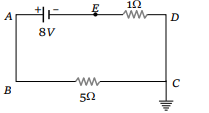
a) Zero
b) - 8 V
c) - 4 / 3 V
d) 4/3 V
Explanation:

2.If a resistance R2 is connected in parallel with
the resistance R in the circuit shown, then
possible value of current through R and the
possible value of R2 will be

a) \[\frac{I}{3},R\]
b) I,2R
c) \[\frac{I}{3},2R\]
d) \[\frac{I}{2},R\]
Explanation:
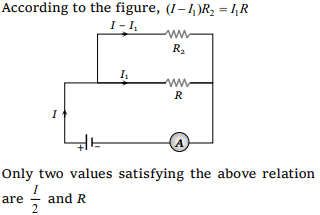
3.Four wires AB, BC, CD, DA of resistance 4 ohm
each and a fifth wire BD of resistance 8 ohm are
joined to form a rectangle ABCD of which BD is a
diagonal. The effective resistance between the
points A and B is
a) 24 ohm
b) 16 ohm
c) \[\frac{4}{3}ohm\]
d) \[\frac{8}{3}ohm\]
Explanation:

4. A battery of e.m.f. 10 V is connected to resistance
as shown in figure. The potential difference
\[V_{A}-V_{B}\] between the points A and B is
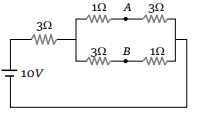
a) - 2 V
b) 2 V
c) 5 V
d) \[\frac{20}{11}V\]
Explanation:
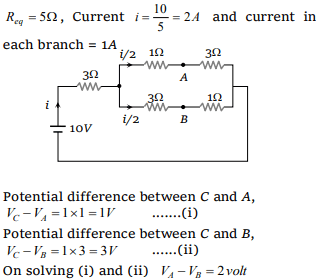
5. Three resistances, each of 1 ohm, are joined in
parallel. Three such combinations are put in
series, then the resultant resistance will be
a) 9 ohm
b) 3 ohm
c) 1 ohm
d) \[\frac{1}{3}ohm\]
Explanation:

6.A student has 10 resistors of resistance ‘r’. The
minimum resistance made by him from given
resistors is
a) 10 r
b) \[\frac{r}{10}\]
c) \[\frac{r}{100}\]
d) \[\frac{r}{5}\]
Explanation: To obtain minimum resistance, all resistors must be connected in parallel.

7. Two wires of same metal have the same length
but their cross-sections are in the ratio 3 : 1 . They
are joined in series. The resistance of the thicker
wire is 10 Ω . The total resistance of the
combination will be
a) 40 Ω
b) \[\frac{40}{3}\] Ω
c) \[\frac{5}{2}\] Ω
d) 100 Ω
Explanation:

8. The equivalent resistance of the following infinite
network of resistances is
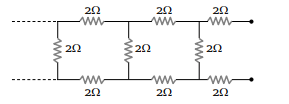
a) Less than 4 Ω
b) 4 Ω
c) More than 4 Ω but less than 12 Ω
d) 12 Ω
Explanation:

9. In the figure given below, the current passing
through 6 Ω resistor is

a) 0.40 ampere
b) 0.48 ampere
c) 0.72 ampere
d) 0.80 ampere
Explanation:

10.Three equal resistances each of value R are joined
as shown in the figure. The equivalent resistance
between M and N is

a) R
b) 2R
c) \[\frac{R}{2}\]
d) \[\frac{R}{3}\]
Explanation:
